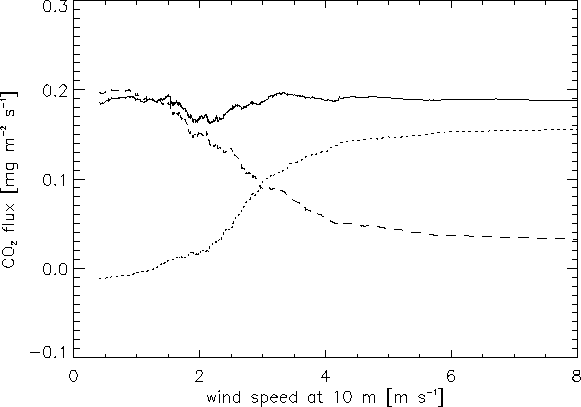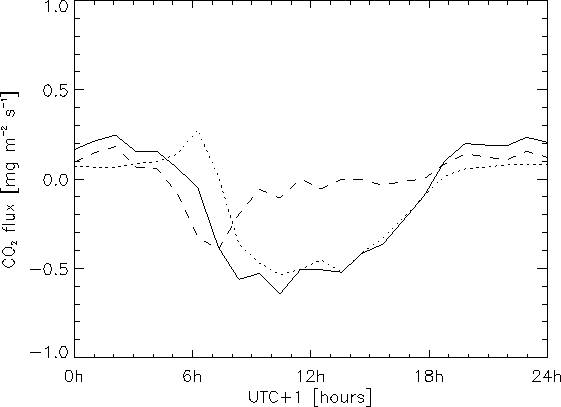The final question that should be addressed here is the accuracy of the measurement. Because of the large amount of data and the nature of the measuring system, countless error sources should be handled to conduct an accurate, reliable long-term measurement and finally to find a NEE value that is considered to be ``defensible''. It was emphasised previously that great effort has been done to assure measurement quality.
Berger et al. (2001) estimates the uncertainty in the eddy flux measurements
by a system very similar to ours to be around 2-4%. The possible error sources
are: uncertainty in the calibration (average coefficients are used for voltage
conversion during days with missing profile data), spectral degradation (which
is correctable), and the random nature of turbulence. Storage change calculations
are needed to compute NEE accurately (see section ![]() ). It is hard
to estimate the error in the storage change calculations because of the several
influencing factors, but we may estimate the overall random error of NEE to
be around 20%, as it is generally assumed for EC measurements (Foken and Wichura,
1996).
). It is hard
to estimate the error in the storage change calculations because of the several
influencing factors, but we may estimate the overall random error of NEE to
be around 20%, as it is generally assumed for EC measurements (Foken and Wichura,
1996).
Energy balance closure test is applied by several authors (Greco and Baldocchi, 1996; Valentini et al., 1996; Baldocchi et al., 1997; Yamamoto et al., 1999; etc.) to test the validity of the EC measurement.
Since soil heat flux measurements are not yet realized at the site, it is estimated
to be 10% of the net radiation. Using this approximation, the closure is about
63% (H+LE=0.63(R![]() -G)-12 W m
-G)-12 W m![]() , where R
, where R![]() is net
radiation and G is the soil heat flux; r=0.62, n=4282) for the 82 m system.
Earlier we have demonstrated that a part of the closure imbalance is caused
by the inadequate spectral response of the temperature fluctuation sensor (see
section
is net
radiation and G is the soil heat flux; r=0.62, n=4282) for the 82 m system.
Earlier we have demonstrated that a part of the closure imbalance is caused
by the inadequate spectral response of the temperature fluctuation sensor (see
section ![]() ). However, this effect can not be responsible alone
for the energy closure imbalance.
). However, this effect can not be responsible alone
for the energy closure imbalance.
The closure is about 77% for the 3 m system (H+LE=0.77(R![]() -G)-31.5 W m
-G)-31.5 W m![]() ,
r=0.93, n=3256).
,
r=0.93, n=3256).
Possible causes of incomplete energy balance closure are errors in the spatial
characterization of net radiation sensor (Schmid, 1997), advection and spatial
variability of albedo and outgoing radiation (Anthoni et al., 1999). Furthermore,
onset of a true mean vertical velocity may cause incomplete closure (Lee, 1998).
As it was mentioned earlier, a mean vertical velocity of 5 cm s![]() at the EC measurement height may produce 100 W m
at the EC measurement height may produce 100 W m![]() energy balance
deficit.
energy balance
deficit.
In a recent paper of Anthoni et al. (1999) concludes that ``it is very difficult to judge the validity of eddy covariance measurements in open-canopy ecosystems by testing the energy budget closure''. Consequently, an incomplete energy balance does not neccessarily mean failure in the scalar fluxes.
Moncrieff et al. (1996) demonstrates the importance of random and systematic errors that may occur during long term ecosystem studies. The basic problem is trivial: if we fail to detect a part of the fluxes systematically (more precisely, selective-systematically), this may result in a huge error in the estimation of the net budget.
The effect of random errors (e.g. nonstationarity, random instrument noise, intermittency, etc.) disappears if the data set consists of several days of data (Moncrieff et al., 1996; Grelle, 1997). Since our measurement covers several days, furthermore a part of the random errors are filtered out (nonstationarity), we only need to focus on systematic errors (see figure 5 in Moncrieff et al., 1996 on page 236). We should note that a varying flux footprint generally causes a random error, but our system was basically built over a heterogeneous landscape, which means that variability in the flux footprint is expected and allowed.
Based on this reasoning, we may try to evaluate the possible selective systematic errors in the measurement.
Advection is an important phenomenon which can cause selective systematic errors
(Yi et al., 2000; Moncrieff et al., 1996). Yi et al. (2000) estimates the effect
of the advection from a multilevel EC system to a 30 m (virtual) tower to be
around 10%. Recently, Lee (1998) proposed a one dimensional method to account
for advection, as it was described in section ![]() . The method is successfully
applied to a couple of sites (e.g. Baldocchi et al., 2000; Paw U. et al., 2000).
As we saw it before in section
. The method is successfully
applied to a couple of sites (e.g. Baldocchi et al., 2000; Paw U. et al., 2000).
As we saw it before in section ![]() , application of Lee's correction
to our site provided ecologically incorrect results, and it is not used. The
advection should not be treated in a one dimensional framework as it is proposed
by Lee (1999), but surprisingly, "the advection correction proposed
by Lee ... appears to improve energy and carbon budget closure at some sites."
(Finnigan, 1999).
, application of Lee's correction
to our site provided ecologically incorrect results, and it is not used. The
advection should not be treated in a one dimensional framework as it is proposed
by Lee (1999), but surprisingly, "the advection correction proposed
by Lee ... appears to improve energy and carbon budget closure at some sites."
(Finnigan, 1999).
Advection may cause selective systematic (nighttime) underestimation of NEE according to many authors (Grace et al., 1996; Greco and Baldocchi, 1996; Baldocchi et al., 2000; Paw U. et al., 2000, Markkanen et al., 2001).
Following the method of Grace et al. (1996), we can investigate whether nighttime flux loss occurs at our site or not (Markkanen et al., 2001).

|
Figure ![]() shows nighttime values of NEE and its subcomponents
(eddy flux at 82 m and storage term) as a function of wind speed at the lowest
level (10 m). The figure suggests that there is no ``lost flux'' during nighttime
caused by advection (NEE does not decline at low wind speeds). The behaviour
of the subcomponents is consistent: at low wind speed (when inversion builds
up), the eddy flux is close to zero, i.e. no respired CO
shows nighttime values of NEE and its subcomponents
(eddy flux at 82 m and storage term) as a function of wind speed at the lowest
level (10 m). The figure suggests that there is no ``lost flux'' during nighttime
caused by advection (NEE does not decline at low wind speeds). The behaviour
of the subcomponents is consistent: at low wind speed (when inversion builds
up), the eddy flux is close to zero, i.e. no respired CO![]() reaches
the eddy level but remains trapped below the 82 m level. This assumes an air
layer where the CO
reaches
the eddy level but remains trapped below the 82 m level. This assumes an air
layer where the CO![]() concentration is gradually growing, that must
appear in the rate of change of storage. Clearly, as the figure shows, the storage
term is responsible for the whole NEE at the lowest wind speeds. As nighttime
wind speed increasing, eddy flux becomes a more and more significant term in
NEE while the importance of the storage term is decreasing. At wind speeds about
3 m s
concentration is gradually growing, that must
appear in the rate of change of storage. Clearly, as the figure shows, the storage
term is responsible for the whole NEE at the lowest wind speeds. As nighttime
wind speed increasing, eddy flux becomes a more and more significant term in
NEE while the importance of the storage term is decreasing. At wind speeds about
3 m s![]() the importance of the two term is in equal. At wind speeds
higher than 4 m s
the importance of the two term is in equal. At wind speeds
higher than 4 m s![]() the largest part of NEE is represented by the
eddy flux term, which means that the lower air layer is well mixed by shear
induced turbulence.
the largest part of NEE is represented by the
eddy flux term, which means that the lower air layer is well mixed by shear
induced turbulence.
The close match between NEE values at low and high wind speeds provides confidence that nocturnal NEE measurements are reliable (Grace et al., 1996), thus advection does not seem to cause systematic error in the measurement (but may cause random errors). This may be caused by the fact that the terrain around the tower site is quite level.
Following a night with high amount of CO![]() accumulated in the lower
air layer, during the morning transition this CO
accumulated in the lower
air layer, during the morning transition this CO![]() may flush out to
the upper air layers. This phenomena is observed by e.g. Yi et al. (2000), Grace
et al. (1996) and Moncrieff et al. (1996), but there are sites where this phenomena
is rare (e.g. Anthoni et al., 1999). Considering our site, it is not possible
that the vegetation may take up this accumulated CO
may flush out to
the upper air layers. This phenomena is observed by e.g. Yi et al. (2000), Grace
et al. (1996) and Moncrieff et al. (1996), but there are sites where this phenomena
is rare (e.g. Anthoni et al., 1999). Considering our site, it is not possible
that the vegetation may take up this accumulated CO![]() during the morning
breakup of the inversion layer, thus it may appear both in the eddy flux measured
at 82 m and at the storage term.
during the morning
breakup of the inversion layer, thus it may appear both in the eddy flux measured
at 82 m and at the storage term.

|
Figure ![]() shows the monthly mean daily cycle of net ecosystem
CO
shows the monthly mean daily cycle of net ecosystem
CO![]() exchange, the eddy flux measured at 82 m and the rate of change
of storage term as measured during August 1999. The large peak in the eddy flux
really present, but it is compensated by the storage term leading an ecologically
acceptable daily NEE course.
exchange, the eddy flux measured at 82 m and the rate of change
of storage term as measured during August 1999. The large peak in the eddy flux
really present, but it is compensated by the storage term leading an ecologically
acceptable daily NEE course.
Consequently, our NEE measurement can be considered reliable, and not contaminated by selective systematic errors (Moncrieff et al., 1996) caused by advection or underestimation of nighttime respiratory rates. This is also valid for the local, 3 m system. The main reason of this may be the good choice of the measuring site.
We should note that more complicated problems occur with measurements conducted in forested environments (e.g. Grelle, 1997; Anthoni et al., 1999; Yamamoto et al., 1999; Baldocchi et al., 2000; Paw U. et al, 2000; Yi et al., 2000). The problem is even more complicated if the terrain is not flat (Bladocchi et al., 2000; Yamamoto et al., 1999).
It is generally accepted that the long term precision of eddy covariance flux
measurements is ![]() 5-10% and the confidence interval about an annual
estimate of NEE is
5-10% and the confidence interval about an annual
estimate of NEE is ![]() 30 g C m
30 g C m![]() year
year![]() (Running
et al., 1999).
(Running
et al., 1999).